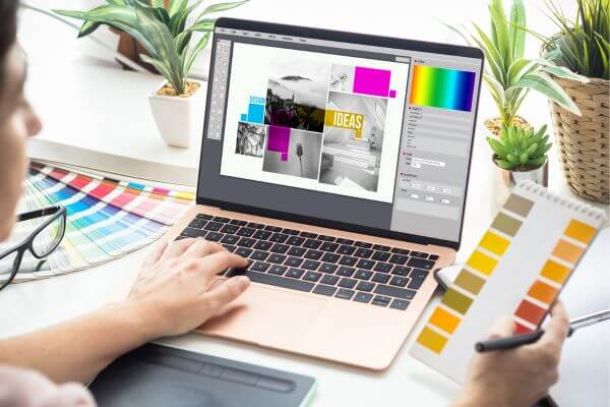Tips for Creating Memorable and Impactful Logos
Tips for Creating Memorable and Impactful Logos
A logo serves as the visual representation of a brand and plays a crucial role in establishing brand identity and recognition. Creating a memorable and impactful logo requires careful consideration of various design elements and principles. In this article, we will explore essential tips and guidelines for crafting logos that leave a lasting impression on viewers.
Understand the Brand and Target Audience
Before diving into the logo design process, it’s crucial to have a deep understanding of the brand’s values, personality, and target audience. Conduct research and gather insights into the brand’s mission, values, and desired brand positioning. Understanding the target audience’s preferences, demographics, and psychographics will help create a logo that resonates with them.
Keep it Simple and Scalable
Simplicity is key when it comes to logo design. A simple logo tends to be more memorable, versatile, and effective in different applications and sizes. Aim for a clean and uncluttered design that can be easily recognized and understood at a glance. Avoid using excessive details or complex illustrations that may be difficult to reproduce in smaller sizes or on different mediums.
Focus on Originality and Uniqueness
A memorable logo stands out from the crowd by being unique and original. Strive to create a logo that captures the essence of the brand while setting it apart from competitors. Conduct a thorough analysis of existing logos in the industry to ensure your design is distinctive and avoids unintentional similarities.
Incorporate Meaningful Symbols and Typography
Symbols and typography are powerful tools in logo design. Choose symbols or icons that align with the brand’s values, core message, or industry. Additionally, select typography that complements the symbol and reflects the brand’s personality. Customizing or modifying typefaces can add a unique touch to the logo.
Ensure Versatility and Adaptability
A well-designed logo should be versatile and adaptable to various contexts and mediums. Consider how the logo will appear across different platforms, such as websites, social media, packaging, and print materials. Test the logo in different sizes and color variations to ensure it remains legible and impactful.
Optimize Color Choice
Color plays a significant role in logo design, evoking emotions and conveying messages. Choose colors that align with the brand’s personality and values while considering the psychology of colors. Additionally, ensure the logo remains effective in grayscale or black and white, as it may be necessary in certain applications.
Test and Iterate
Once you have a logo design concept, it’s essential to test its effectiveness. Gather feedback from stakeholders, target audience members, or design professionals to gain different perspectives. Iterate and refine the design based on the feedback received, paying attention to minor adjustments that can significantly impact the logo’s overall impact.
Consider Longevity
A successful logo should stand the test of time. Avoid overly trendy elements or design choices that may quickly become outdated. Aim for a logo that remains relevant and timeless, allowing the brand to maintain consistency and recognition over the years.
Seek Professional Assistance if Needed
Designing a logo can be a complex task, and seeking professional assistance is often beneficial. Experienced logo designers can provide expertise, fresh insights, and a refined design process that ensures a high-quality and impactful logo.
Protect Your Logo
Once you have a finalized logo design, it’s essential to protect it by registering for trademark rights or copyright. This safeguards your logo from being used by others and helps maintain the exclusivity and integrity of your brand identity.
Consider Negative Space
Negative space refers to the area surrounding and between the elements of a logo. It can be used strategically to create hidden symbols or to add depth and visual interest. Cleverly incorporating negative space in a logo design can make it more memorable and impactful. Look for opportunities to leverage negative space to convey hidden messages or to create a sense of intrigue.
Test Logo Legibility and Visibility
A logo’s primary purpose is to be easily recognizable and legible. Test the logo design across various backgrounds and sizes to ensure it remains clear and readable. Consider the logo’s visibility in different scenarios, such as on digital screens, in print, or when viewed from a distance. If necessary, make adjustments to enhance legibility and ensure the logo remains impactful in different contexts.
Embrace Minimalism
Minimalistic logo design has become increasingly popular due to its simplicity and timeless appeal. Minimalist logos feature clean lines, minimal details, and a focus on essential elements. By stripping away unnecessary elements, a minimalist logo can communicate a brand’s identity in a concise and impactful manner. Embracing minimalism can help create a logo that is both memorable and versatile.
Understand Logo Psychology
Logo design goes beyond aesthetics; it also involves understanding the psychology behind colors, shapes, and typography. Different colors evoke different emotions and have distinct connotations. Shapes can convey specific meanings or associations. Typography choices can also influence the perception of a brand’s personality. Dive into the psychology of design elements to create a logo that resonates with the target audience on a deeper level.
Create a Style Guide
A comprehensive style guide helps maintain consistency in logo usage across different platforms and materials. It outlines guidelines for logo placement, sizing, color variations, and any accompanying elements. A well-designed style guide ensures that the logo retains its impact and integrity, even when used by different individuals or departments. It serves as a reference point for anyone working with the logo, ensuring its consistent representation.
Evolve with Time
While it’s important to create a logo that stands the test of time, it’s also essential to be open to evolution. As brands grow and evolve, they may need to refresh or update their logo to reflect their new direction. Keep an eye on industry trends and periodically assess whether the logo aligns with the brand’s current positioning. If necessary, make strategic adjustments to maintain relevance while staying true to the brand’s core identity.
Stay Inspired and Informed
The world of design is constantly evolving, and staying inspired and informed is crucial for creating impactful logos. Follow design blogs, attend industry events, and explore design communities to keep up with the latest trends and techniques. Engaging with the design community and seeking inspiration from various sources can fuel creativity and lead to breakthrough logo designs.
Test Logo Adaptability in Different Contexts
To ensure the logo’s effectiveness, it’s important to test its adaptability in different contexts. Consider how the logo will appear on various surfaces, such as merchandise, signage, or digital advertisements. Test its visibility and legibility in different lighting conditions and backgrounds. By conducting thorough testing, you can ensure that the logo maintains its impact and readability across various applications.
Tell a Story with the Logo
A logo can tell a story and communicate the brand’s values and message. Consider incorporating elements or symbols that represent the brand’s story, heritage, or mission. A logo that has a narrative behind it can create a deeper connection with the audience and leave a lasting impression. Use design elements strategically to convey the brand’s story and evoke emotions.
Seek Inspiration from Unexpected Sources
Inspiration can come from anywhere, so don’t limit yourself to traditional design sources. Look for inspiration in art, nature, architecture, or even cultural references. Exploring unexpected sources can spark unique ideas and lead to innovative logo designs. Keep an open mind and allow yourself to be inspired by the world around you.
Optimize for Digital Platforms
In today’s digital world, it’s important to optimize your logo for digital platforms. Consider how the logo will appear on websites, social media profiles, and mobile apps. Ensure that the logo scales well and remains visually appealing on screens of various sizes. Additionally, make sure the logo is compatible with different file formats and can be easily incorporated into digital designs.
Consider Animation Possibilities
With the rise of motion graphics and animated logos, consider the potential for animating your logo. Animation can add a dynamic and engaging element to your brand identity. Think about how certain elements of your logo could be animated to enhance brand storytelling and create a memorable user experience.
Seek Feedback from Your Target Audience
Your target audience’s opinion matters the most when it comes to evaluating the effectiveness of your logo. Conduct surveys, focus groups, or usability tests to gather feedback from your audience. Understand their perception of the logo, whether it aligns with the brand, and if it leaves a lasting impact. This valuable feedback can guide you in making necessary refinements and improvements to your logo design.
Establish Consistency Across Brand Elements
A cohesive and consistent brand identity is vital for brand recognition. Ensure that your logo aligns with other brand elements such as color palette, typography, and visual style. Consistency across all brand touchpoints creates a unified and professional brand image that reinforces the logo’s impact and helps build trust with the audience.
Plan for Scalability
As your brand grows and expands, your logo may need to be scaled up or down for different applications. Plan ahead for scalability by creating a logo design that can be easily adapted without losing its impact or readability. Consider how the logo will appear on large signage, small promotional items, or even as a favicon on a website. By planning for scalability, you future-proof your logo design and ensure its versatility for any future branding needs.
Conclusion
Creating a memorable and impactful logo requires a combination of creativity, research, and strategic thinking. By considering factors such as adaptability, storytelling, optimization for digital platforms, and scalability, you can craft a logo that stands out, resonates with your audience, and leaves a lasting impression.
Remember, a logo is an investment in your brand’s identity, and it’s worth dedicating time and effort to ensure its effectiveness. By following these tips and guidelines, you can create a logo that becomes a powerful symbol of your brand and helps drive its success.


